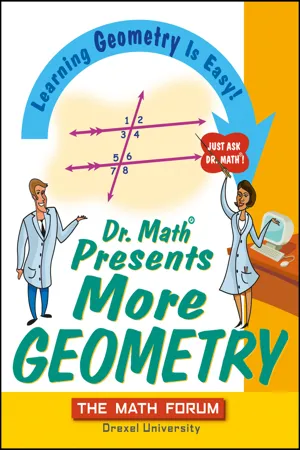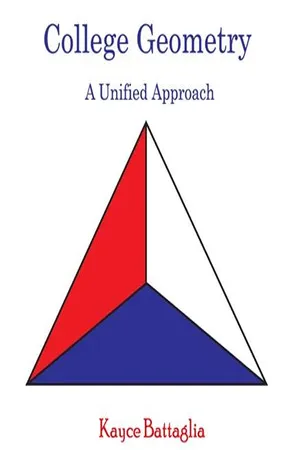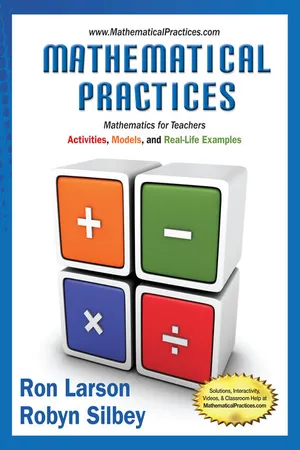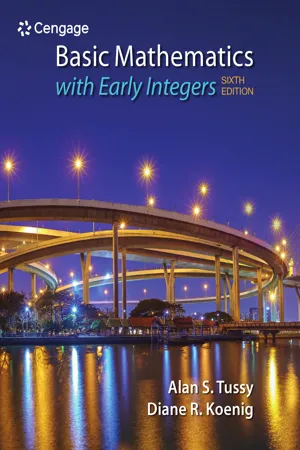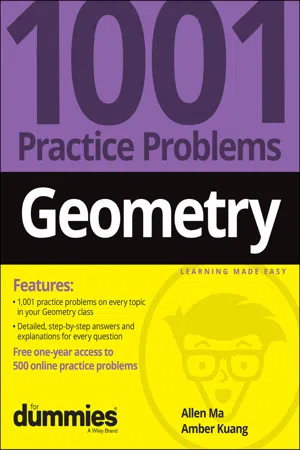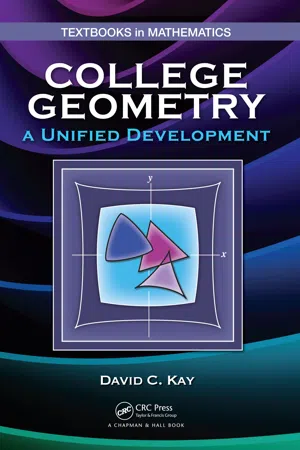Mathematics
SSS and SAS
SSS (Side-Side-Side) and SAS (Side-Angle-Side) are two methods used to prove that two triangles are congruent. SSS states that if the three sides of one triangle are equal to the three sides of another triangle, then the triangles are congruent. SAS states that if two sides and the included angle of one triangle are equal to two sides and the included angle of another triangle, then the triangles are congruent.
Written by Perlego with AI-assistance
Related key terms
1 of 5
9 Key excerpts on "SSS and SAS"
- eBook - PDF
Dr. Math Presents More Geometry
Learning Geometry is Easy! Just Ask Dr. Math
- (Author)
- 2005(Publication Date)
- Jossey-Bass(Publisher)
In this section, we’ll explain how to use these shortcuts, or pos- tulates: SSS (side-side-side), SAS (side-angle-side), and ASA (angle- side-angle). We’ll also show you why SSA (side-side-angle) and AAA (angle-angle-angle) shortcuts won’t work, at least most of the time. 66 Dr. Math Presents More Geometry Dear Dr. Math, Can you please explain how to determine if a shape is congruent using SSS, SAS, and ASA and how and when to use the triangle congruence properties? I have tried, but I just don’t understand it. Please start from the beginning. Thanks. Yours truly, Qian Congruence and Triangles Hi, Qian, First of all, let us agree on the following four things: 1. Two line segments are congruent if and only if they have the same length. If we know that segments FI and SE are each 7.3 cm long, then segment FI is congruent to segment SE, which we can write as FI ≅ SE. 2. Two angles are congruent if and only if they measure the same number of degrees. So if ∠GUS and ∠JON each measure 81 degrees, then ∠GUS and ∠JON are congruent. 3. Congruence of segments and angles is reflexive, transitive, and symmetric. Reflexive means segment AB is congruent to itself; transitive means if segment CD is congruent to segment EF and segment EF is congruent to segment GH, then segment CD is congruent to segment GH; and symmetric means if seg- ment IJ is congruent to segment KL, then segment KL is con- gruent to segment IJ. The same holds true for angles. 4. Two triangles are congruent if and only if they have three pairs of congruent sides and three pairs of congruent angles. Trian- gle ABC and triangle XYZ are congruent if and only if ∠A is congruent to ∠X, ∠B is congruent to ∠Y, ∠C is congruent to ∠Z, side XY is congruent to side AB, side BC is congruent to side YZ, and side AC is congruent to side XZ. Note that when you say two triangles are congruent, you have to get the letters in the proper order to show what’s congruent to what. - No longer available |Learn more
College Geometry
A Unified Approach
- (Author)
- 2014(Publication Date)
- Orange Apple(Publisher)
If triangle ABC is congruent to triangle DEF, the relationship can be written mathematically as: In many cases it is sufficient to establish the equality of three corresponding parts and use one of the following results to deduce the congruence of the two triangles. The shape of a triangle is determined up to congruence by specifying two sides and the angle between them (SAS), two angles and the side between them (ASA) or two angles and a corresponding adjacent side (AAS). Specifying two sides and an adjacent angle (SSA), however, can yield two distinct possible triangles. ________________________ WORLD TECHNOLOGIES ________________________ Determining congruence Sufficient evidence for congruence between two triangles in Euclidean space can be shown through the following comparisons: • SAS (Side-Angle-Side): If two pairs of sides of two triangles are equal in length, and the included angles are equal in measurement, then the triangles are congruent. • SSS (Side-Side-Side): If three pairs of sides of two triangles are equal in length, then the triangles are congruent. • ASA (Angle-Side-Angle): If two pairs of angles of two triangles are equal in measurement, and the included sides are equal in length, then the triangles are congruent. The ASA Postulate was contributed by Thales of Miletus (Greek). In most systems of axioms, the three criteria— SAS , SSS and ASA —are established as theorems. In the School Mathematics Study Group system SAS is taken as one (#15) of 22 postulates. • AAS (Angle-Angle-Side): If two pairs of angles of two triangles are equal in measurement, and a pair of corresponding non-included sides are equal in length, then the triangles are congruent. • RHS (Right-angle-Hypotenuse-Side): If two right-angled triangles have their hypotenuses equal in length, and a pair of shorter sides are equal in length, then the triangles are congruent. - eBook - PDF
- Daniel C. Alexander, Geralyn M. Koeberlein(Authors)
- 2019(Publication Date)
- Cengage Learning EMEA(Publisher)
Each letter of SSS refers to a pair of congruent sides. 3.1 ■ Congruent Triangles 139 U T V (a) A C B (b) Figure 3.5 Informally, the term include names the part of a triangle that is “between” two other named parts. In a triangle, two sides include an angle, while two angles include a side. The two sides that include the angle actually form the angle. The two angles that include a side share that side. EXAMPLE 4 In uni2206ABC of Figure 3.5(b): a) Which angle is included by AC and CB ? b) Which sides include uni2220B? c) What is the included side for uni2220A and uni2220B? d) Which angles include CB ? SOLUTION a) uni2220C (because this angle is formed by AC and CB ) b) AB and BC (because these sides form uni2220B) c) AB (because it is the common side for uni2220A and uni2220B) d) uni2220C and uni2220B (because CB is a side of each angle) SAS (METHOD FOR PROVING TRIANGLES CONGRUENT) A second way of establishing that two triangles are congruent involves showing that two sides and the included angle of one triangle are congruent to two sides and the included angle of a second triangle. If two people each draw a triangle so that two of the sides mea- sure 2 cm and 3 cm and their included angle measures 54°, then those triangles are con- gruent. See Figure 3.6. POSTULATE 13 If two sides and the included angle of one triangle are congruent to two sides and the included angle of a second triangle, then the triangles are congruent (SAS). The order of the letters SAS in Postulate 13 helps us to remember that the two sides that are named have the angle “between” them; that is, the two sides referred to by S and S form the angle, represented by A. In Example 5 on page 140, the two triangles to be proved congruent share a common side; the statement PN _ PN is justified by the Reflexive Property of Congruence, which is conveniently expressed as Identity. - eBook - PDF
Mathematical Practices, Mathematics for Teachers
Activities, Models, and Real-Life Examples
- Ron Larson, Robyn Silbey(Authors)
- 2014(Publication Date)
- Cengage Learning EMEA(Publisher)
All Rights Reserved. May not be copied, scanned, or duplicated, in whole or in part. Due to electronic rights, some third party content may be suppressed from the eBook and/or eChapter(s). Editorial review has deemed that any suppressed content does not materially affect the overall learning experience. Cengage Learning reserves the right to remove additional content at any time if subsequent rights restrictions require it. Section 13.1 Congruence of Triangles 495 13.1 Congruence of Triangles Understand the definition of congruent triangles. Use the SSS, SAS, and ASA Congruence Postulates. Use congruent triangles to explore properties of parallelograms. Congruent Triangles Recall from Chapter 10 that line segments are congruent when they have the same length, and angles are congruent when they have the same measure. Congruent figures have the same size and shape. Standards Grades 3–5 Geometry Students should classify shapes by properties of their lines and angles. Grades 6–8 Geometry Students should describe the relationships between geometrical figures. Definition of Congruent Triangles Two triangles are congruent triangles when their corresponding sides are congruent and their corresponding angles are congruent. In the figures below, triangle ABC is congruent to triangle DEF. C B A F E D Matching sides are called corresponding sides. Matching angles are called corresponding angles. △ABC ≅ △DEF The symbol ≅ means “is congruent to.” When writing statements such as △ABC ≅ △DEF, you can start at any vertex. Just be sure to list the vertices of the triangles in corresponding order. EXAMPLE 1 Using the Definition of Congruent Triangles △JKL is congruent to △XYZ. J K L Y 10 cm X Z 75° 65° a. Find the length of — JK. b. Find the measures of angles J and L. SOLUTION a. Because △JKL ≅ △XYZ, the corresponding sides — JK and — XY are congruent. So, the length of — JK is the same as the length of — XY . - Alan Tussy, Diane Koenig(Authors)
- 2018(Publication Date)
- Cengage Learning EMEA(Publisher)
We can show that the triangles shown below are congruent by the ASA property: R C P Q A B 9 9 82° 82° 60° 60° H11028P H11061 H11028B Since m(P ) 5 60° and m(B ) 5 60°, the angles are congruent. PR H11061 BC Since m(PR ) 5 9 and m(BC ) 5 9, the segments are congruent. H11028R H11061 H11028C Since m(R ) 5 82° and m(C ) 5 82°, the angles are congruent. Therefore, ^PQR H11061 ^BAC . There is no SSA property. To illustrate this, consider the triangles shown below. Two sides and an angle of ^ABC are congruent to two sides and an angle of ^DEF . But the congruent angle is not between the congruent sides. We refer to this situation as SSA. Obviously, the triangles are not congruent because they are not the same shape and size. The tick marks indicate congruent parts. That is, the sides with one tick mark are the same length, the sides with two tick marks are the same length, and the angles with one tick mark have the same measure. A D F E C B Explain why the triangles in the figure on the following page are congruent. Strategy We will show that two sides and the angle between them in one triangle are congruent, respectively, to two sides and the angle between them in a second triangle. EXAMPLE 2 Copyright 2019 Cengage Learning. All Rights Reserved. May not be copied, scanned, or duplicated, in whole or in part. Due to electronic rights, some third party content may be suppressed from the eBook and/or eChapter(s). Editorial review has deemed that any suppressed content does not materially affect the overall learning experience. Cengage Learning reserves the right to remove additional content at any time if subsequent rights restrictions require it. 9.5 • Congruent Triangles and Similar Triangles 753 WHY Then we know that the two triangles are congruent by the SAS property.- eBook - PDF
Mathematics for Elementary Teachers
A Contemporary Approach
- Gary L. Musser, Blake E. Peterson, William F. Burger(Authors)
- 2013(Publication Date)
- Wiley(Publisher)
Is Roberto correct? Discuss. GEOMETRIC PROBLEM SOLVING USING TRIANGLE CONGRUENCE AND SIMILARITY The two parallelograms below have congruent corresponding sides, but the parallelograms themselves are not congruent. The two tri- angles below have congruent corresponding sides and, by the SSS triangle congruence, the triangles are congruent. These two ideas are related to some principles of fence building. When building a gate for a fence, a crosspiece (A), like the one shown, is added to ensure a stron- ger more stable gate that won’t sag. Why does the diagonal (A) add so much strength that the two parallel pieces (B and C ) couldn’t provide? How is this strengthening crosspiece related to the SSS triangle congruence? 766 Chapter 14 Geometry Using Triangle Congruence and Similarity Applications of Triangle Congruence In this section we apply triangle congruence and similarity properties to prove properties of geometric shapes. Many of these results were observed informally in Chapter 12. Our first result is an application of the SAS congruence property that establishes a property of the diagonals of a rectangle. Problem-Solving Strategy Draw a Picture Show that the diagonals of a rectangle are congruent. SOLUTION Suppose that ABCD is a rectangle [Figure 14.50(a)]. Figure 14.50 A B D C AC = BD (a) A B D C (b) Then ABCD is a parallelogram (from Chapter 12). By a theorem in Section 14.1, the opposite sides of ABCD are congruent [Figure 14.50(b)]. In particular, AB DC ≅ . Consider nABC and n n DCB; ABC C ≅ ∠D B, since they are both right angles. Also, CB BC ≅ . Hence, n n ABC DCB ≅ by the SAS congruence property. Consequently, AC BD ≅ , as desired. ■ The next result is a form of a converse of the theorem in Example 14.11. In parallelogram ABCD, if the diagonals are congruent, it is a rectangle. SOLUTION Suppose that ABCD is a parallelogram with AC BD ≅ [Figure 14.51(a)]. Figure 14.51 Since ABCD is a parallelogram, AD BC ≅ . - Allen Ma, Amber Kuang(Authors)
- 2022(Publication Date)
- For Dummies(Publisher)
Each given should be used separately to draw its own conclusion. » If you’ve used all your given information and still require more to prove the triangles congruent, look for the reflexive property or a pair of vertical angles. » After you find angles or segments congruent, mark them in your diagram. The markings make it easier for you to see what other information you need to complete the proof. » To prove parts of a triangle congruent, you’ll first need to prove that the triangles are congruent to each other using the proper triangle congruence theorems. Chapter 3 18 PART 1 The Questions Triangle Congruence Theorems 86–102 Use your knowledge of SAS, ASA, SSS, and AAS to solve the problem. 86. What method can you use to prove these two triangles congruent? 87. What method can you use to prove these two triangles congruent? 88. What method can you use to prove these two triangles congruent? 89. What method can you use to prove ABC EDC ? 90. Which pair of segments or angles would need to be proved congruent in order to prove these triangles congruent using the SSS method? 91. Which pair of segments or angles would need to be proved congruent in order to prove these triangles congruent using the SAS method? CHAPTER 3 Geometric Proofs with Triangles 19 92. Which pair of segments or angles would need to be proved congruent in order to prove these triangles congruent using the AAS method? 93. Which pair of segments or angles would need to be proved congruent in order to prove these triangles congruent using the ASA method? 94. Which pair of segments or angles would need to be proved congruent in order to prove these triangles congruent using the SSS method? 95. Which pair of segments or angles would need to be proved congruent in order to prove the triangles congruent using the SAS method? 96. Given: SE bisects RST and E is the midpoint of RT . Is it possible to prove RSE TSE using only the given infor-mation and the reflexive property? 97.- No longer available |Learn more
- Daniel C. Alexander, Geralyn M. Koeberlein, , , Daniel C. Alexander, Geralyn M. Koeberlein(Authors)
- 2014(Publication Date)
- Cengage Learning EMEA(Publisher)
Identity 5. SAS ∠ s ∠ Copyright 2013 Cengage Learning. All Rights Reserved. May not be copied, scanned, or duplicated, in whole or in part. Due to electronic rights, some third party content may be suppressed from the eBook and/or eChapter(s). Editorial review has deemed that any suppressed content does not materially affect the overall learning experience. Cengage Learning reserves the right to remove additional content at any time if subsequent rights restrictions require it. 142 CHAPTER 3 ■ TRIANGLES General Rule: An early statement of the proof establishes the “helping line,” such as the altitude or the angle bisector. Illustration: See the second line in the proof of Example 2. The chosen angle bisector leads to congruent triangles, which enable us to complete the proof. STRATEGY FOR PROOF ■ Using an Auxillary Line EXAMPLE 2 Give a formal proof of Theorem 3.3.3. GIVEN: Isosceles with [See Figure 3.31(a).] PROVE: NOTE: Figure 3.31(b) shows the auxiliary segment, the bisector of . PROOF Statements Reasons For the proof of Theorem 3.3.3, a different angle bisector (such as the bisector of ) would not lead to congruent triangles; that is, the choice of auxiliary line must lead to the desired outcome! Theorem 3.3.3 is sometimes stated, “The base angles of an isosceles triangle are congruent.” We apply this theorem in Example 3. EXAMPLE 3 Find the size of each angle of the isosceles triangle shown in Figure 3.32 on page 143 if: a) b) The measure of each base angle is less than twice the measure of the vertex angle SOLUTION a) . Since and and are we have Thus, and . m ∠ 2 m ∠ 3 72 m ∠ 1 36 m ∠ 2 72 2(m ∠ 2) 144 36 2(m ∠ 2) 180 , ∠ 3 ∠ 2 m ∠ 1 36 m ∠ 1 m ∠ 2 m ∠ 3 180 5 m ∠ 1 36 ∠ M ∠ MPN ∠ M ∠ N MP NP MNP P M N (a) P M N (b) Q THEOREM 3.3.3 If two sides of a triangle are congruent, then the angles opposite these sides are also congruent. Figure 3.31 1. Isosceles with 2. Draw bisector from P to 3. - eBook - PDF
College Geometry
A Unified Development
- David C. Kay(Author)
- 2011(Publication Date)
- CRC Press(Publisher)
But also, BA ′ = BA = BC by hypothesis and by (7) , Section 1.8 , A ′ = C . Thus A → C . This fact will be used in the SAS theorem below. We are now ready for the main theorem (Euclid’s proposition I.4), which is implied by Axiom M , and a rigorous argument can be given for it. SAS Congruence Criterion from Axiom M If two sides and the included angle of one triangle are congruent to the corresponding two sides and included angle of another triangle, then the triangles are congruent. Proof Suppose that in triangles ABC and DEF we have AB = DE , AC = DF , and m ∠ BAC = m ∠ EDF (Figure 3.18). Our goal is to find a motion that maps Δ ABC to Δ DEF . Let M be the midpoint of segment AD (or if AD = α take M as any point midway between A and D ), and let l 1 be the line perpendicular to line AM at M . Then, under the reflection P → P ′ in line l 1 (by Axiom M ), A → A ′ ≡ D , B → B ′ , and C → C ′ . (The shaded triangles in the figure show the images of the given triangle under the reflections to be considered.) Now take the line l 2 containing the bisector of ∠ B ′ DE (unless B ′ = E ) and consider the reflection in l 2 . By previous observations, B ′ → B ″ ≡ E (and D ′ → D ″ ≡ D ). Now, so far, we have the product P → P ′ → P ″ of the two reflections in l 1 and l 2 mapping A to D , B to E , and C to C ″ . Next, consider line l DE 3 = arrowleftnosp arrowrightnosp combarrowextendercombarrowextender (if C ″ ≠ F ). This line contains the bisector of ∠ FEC ″ since by hypothesis m ∠ EDF = m ∠ BAC = m ∠ B ″ A ″ C ″ = m ∠ EDC ″ . (Or, if rays EF and EC are opposite rays, then l FD 3 ⊥ arrowleftnosp arrowrightnosp combarrowextendercombarrowextender and D is midway between F and C ″ .) Thus, if P ″ → P ″′ denotes the reflection in line l 3 , then C ″ maps to F , and D and E are left fixed. The product of the three reflections then maps Δ ABC to Δ DEF . Since motions preserve distance and angle measure, it follows that Δ ABC ≅ Δ DEF .
Index pages curate the most relevant extracts from our library of academic textbooks. They’ve been created using an in-house natural language model (NLM), each adding context and meaning to key research topics.
